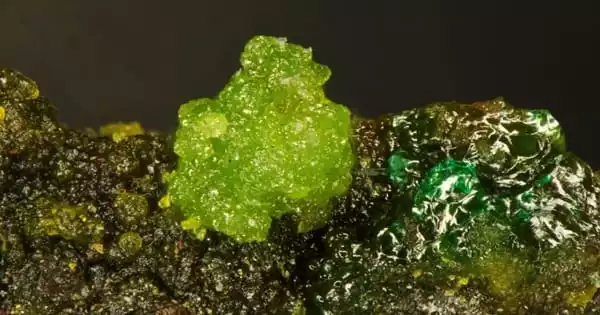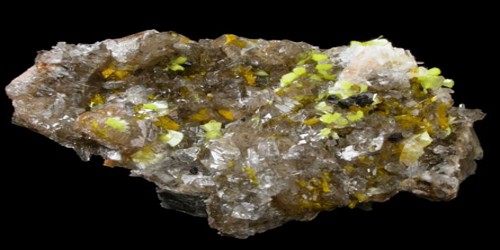The mineral olivine has the chemical formula (Mg2+, Fe2+)2SiO4 and is a magnesium iron silicate. It refers to a class of rock-forming minerals found in mafic and ultramafic igneous rocks such as basalt, gabbro, dunite, diabase, and peridotite. Many people are familiar with olivine because it is the mineral that makes up the popular green gemstone peridot.
It is either a nesosilicate or an orthosilicate. It is a common mineral in the Earth’s subsurface but weathers quickly on the surface. It is the primary component of the Earth’s upper mantle. As a result, as part of climate change mitigation, olivine has been proposed as a good candidate for accelerated weathering to sequester carbon dioxide from the Earth’s oceans and atmosphere. Olivine has a variety of historical applications, including the gemstone peridot (or chrysolite), as well as industrial applications such as metalworking processes.
Olivine gives its name to the group of minerals with a related structure (the olivine group)—which includes tephroite (Mn2SiO4), monticellite (CaMgSiO4), larnite (Ca2SiO4), and kirschsteinite (CaFeSiO4) (commonly also spelled kirschteinite).
General Information
- Category: Nesosilicate (Olivine group)
- Formula: (repeating unit) (Mg,Fe)2SiO4
- Crystal system: Orthorhombic
- Color: Yellow to yellow-green
Properties
Olivine is typically green, but it can also be yellow-green, greenish-yellow, or brown in color. It has a transparent to translucent appearance, a glassy luster, and a hardness of 6.5 to 7.0. It is the only common igneous mineral that possesses these characteristics.
- Crystal habit: Massive to granular
- Cleavage: Poor
- Fracture: Conchoidal – brittle
- Mohs scale hardness: 6.5–7
- Luster: Vitreous
- Streak: None
- Diaphaneity: Transparent to translucent
- Specific gravity: 3.2–4.5
- Optical properties: Biaxial (+)
The crystal structure of olivine includes elements of the orthorhombic P Bravais lattice, which result from each silica (SiO4) unit being joined by metal divalent cations, with each oxygen in SiO4 bound to three metal ions. It has a spinel-like structure similar to magnetite, but instead of two trivalent and one divalent cation, it uses one quadrivalent and two divalent cations M22+M4+O4.

Occurrences
The majority of olivine found on Earth’s surface is found in dark-colored igneous rocks. It is found in both mafic and ultramafic igneous rocks, as well as as a primary mineral in some metamorphic rocks. Ultramafic rocks typically contain significant olivine, and those with an olivine content greater than 40% are referred to as peridotites. Dunite contains more than 90% olivine and is most likely a cumulate formed by olivine crystallizing and settling out of magma or a vein mineral lining magma conduits.
Olivine and high-pressure structural variants account for more than half of the Earth’s upper mantle, and olivine is one of the most abundant minerals by volume. Metamorphism of impure dolomite or other sedimentary rocks with high magnesium and low silica content results in Mg-rich olivine, also known as forsterite.
Uses
In the steel industry, olivine is used as a substitute for dolomite. It is a rare mineral that is rarely used in industry. The majority of olivine is used as a slag conditioner in metallurgical processes. Forsterite (high-magnesium olivine) is added to blast furnaces to remove impurities from steel and form slag.
Olivine sand is used in the aluminum foundry industry to cast objects in aluminum. While still holding the mold together during handling and metal pouring, olivine sand requires less water than silica sands. As metal is poured into the mold, less water means less gas (steam) to vent from the mold.
Olivine has also been used in refractory applications. It is used in the manufacture of refractory bricks and as casting sand. Both of these applications are declining as alternative materials become less expensive and easier to obtain.
















